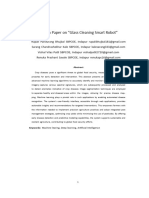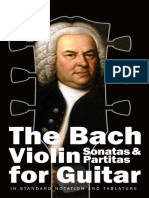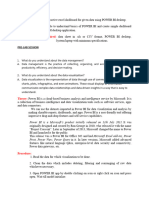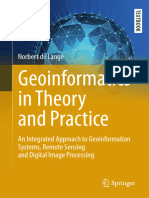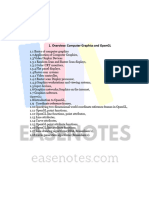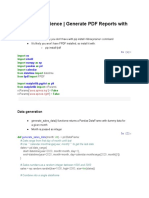IoT Based Precision Farming
IoT Based Precision Farming
Copyright:
Available Formats
IoT Based Precision Farming
IoT Based Precision Farming
Copyright
Available Formats
Share this document
Did you find this document useful?
Is this content inappropriate?
Copyright:
Available Formats
IoT Based Precision Farming
IoT Based Precision Farming
Copyright:
Available Formats
Volume 9, Issue 9, September – 2024 International Journal of Innovative Science and Research Technology
ISSN No:-2456-2165 https://doi.org/10.38124/ijisrt/IJISRT24SEP1159
IoT Based Precision Farming
Elvin Paul K S1; Sudha B2; Abhishek S3; Supreeth Raj M4; Nagababau A V5
UG Scholar-ETE1,3,4,5; Assistant Professor –ETE2
Bangalore institute of Technology
Bangalore, Karnataka
Abstract: - This project focuses on leveraging drone depths, incorporating sensors for monitoring humidity and
images of the pests equipped with advanced sensors for temperature.
pest detection in crops, combined with methods for image
processing to identify diseases. The ultimate goal is to This system has two main sections, monitoring station
enhance crop health and productivity through timely and and control station, which are intercommunicated using/aided
targeted pesticide application. Image processing by the wireless Zigbee or Wi-Fi communication technologies.
techniques are used to detect signs of diseases and pests in The control station as well as robotic station possesses the
the captured images. The use of machine learning CNN amenities which is soil moisture sensor, ultraviolet sensor,
algorithm enhances the system’s ability to accurately robotic system with motors, ARM microcontroller, and
classify and diagnose crop heath issues. Upon detection of power supply. Next, the sick plants will be categorized, and a
pests, the IOT platform triggers a response mechanism to camera equipped with Internet of Things technology will be
deploy a precision pesticide spraying system. This ensures used to take pictures of the afflicted areas of the plants [2].
targeted and localized treatment, reducing the overall use After that, pre-processing, modification, and grouping are
of pesticides and minimizing environmental impact. This applied to these pictures. The processor then receives these
project involves capturing images of pests using a camera, images as input, and using the CNN algorithm, compares the
followed by processing these images to extract key images with the set of tested and pre-trained pests [3].
features using various image processing techniques. The
extracted features are analyzed using algorithms, An automated pesticide sprayer is used to target specific
primarily Convolutional Neural Networks (CNNs), to areas of the leaf for pesticide application if the UAV [4]
detect variations in color and other dominant captured image detects signs of damage. This ensures precise
characteristics in the images. By comparing these features and efficient use of pesticides. If not, it will be automatically
across samples, the system can identify pests and plant discarded by the processors, and the spraying robot [5] will
diseases more efficiently. This approach aims to provide a move further. This project focuses on making an automated
quicker and more cost-effective solution for pest detection system accessible to farmers for early detection of plant
and disease management. diseases. The system integrates robotics, where a drone
captures images, and an onboard processor analyzes them.
Keywords:- CNN, IOT, Sprayer Robot, Image Processing, Once the disease is evaluated, real-time results are sent to the
ZigBee Module, Precision. farmer via a Bluetooth HC-05 Android app and displayed on
an LCD screen for quick access. The process of disease
I. INTRODUCTION detection involves several key steps: digital image capture,
image pre-processing (including noise removal, color
In recent years, robotics in the agricultural sector, driven transformation, and histogram equalization), segmentation
by the principles of precision agriculture, has emerged as an using the K-means algorithm, feature extraction, and
innovative and rapidly growing technology. The primary classification using a support vector machine (SVM), a
drivers of farming process automation are the reduction of supervised learning algorithm. There are two stages to the
time and energy spent on monotonous farming operations and processing that is done with these components. Training
the enhancement of yield productivity through the application Phase, often known as the offline phase, is the first processing
of precision farming principles to each crop on an individual stage. During this stage, an image analyzer examined a set of
basis. The design of such robots is based on specific input photographs of leaves (both damaged and healthy), and
approaches and takes into account the agricultural specific features were extracted. Subsequently, the classifier
environment in which they will operate. Additionally, a received these attributes as input together with the
prototype of an autonomous agricultural robot is introduced, information identifying whether the image depicts a healthy
specifically designed for tasks like spraying pesticides or diseased leaf. Subsequently, the classifier ascertains the
efficiently and autonomously. Robotic systems have a relationship between the retrieved features and the potential
significant impact across various sectors, including society, conclusion about the existence of the disease [7]. The system
organizations, and industries. This research focuses on is trained as a result.
creating an automated device designed for farm operations,
such as pest identification using machine learning [1] and
precise pesticide spraying at predetermined distances and
IJISRT24SEP1159 www.ijisrt.com 2444
Volume 9, Issue 9, September – 2024 International Journal of Innovative Science and Research Technology
ISSN No:-2456-2165 https://doi.org/10.38124/ijisrt/IJISRT24SEP1159
II. LITERATURE SURVEY A. Problems Recognized
From the Literature Survey carried out, several
From Table 1, PAPER-1 refers to The paper discusses problems were identified in the existing technology of pest
the key components of IoT-based smart agriculture systems, detection by drones and spraying methods. They are as
such as sensor nodes, communication protocols, data follows:
analytics platforms, and control mechanisms. It highlights the
importance of each component and their functioning to Pest Infestation in Crops
optimize agricultural practices. Paper 2 refer to the role of Farmers often face challenges in identifying and
OpenCV in analyzing images or video feeds captured from monitoring pest infestations in their crops efficiently.
agricultural fields to identify pests or signs of pest infestation. Traditional methods of pest detection can be time-consuming
It encompasses a range of image processing techniques, and may not provide real- time information.
including segmentation, feature extraction, and classification.
Inefficient Pesticide Use
Paper-3 refers to the integration of AI technology with Conventional methods of pesticide application may
UAVs for pest recognition purposes. It discusses the result in over use or under use, leading to increased costs
hardware and software components of the AI drone system, and potential environmental harm. Lack of precision in
including the UAV platform, on board cameras, pesticide application can harm non-target organisms and soil
computational resources, and software algorithms for image health
analysis. Paper-4 refers to the process of training the deep
learning model on the dataset and fine-tuning its parameters Manual Monitoring and Treatment.
to optimize performance. It also presents the results from Monitoring and treating crops manually are labor-
performance evaluations, including metrics such as accuracy intensive tasks, and the effectiveness of pest management
and precision. These papers have respective drawbacks such may vary. Timely intervention is crucial, and delays in
as connectivity issues, improper detection, outdated identifying and addressing pest issues can lead to crop losses.
technology and also problem in retrieval of the given data.
Table 1: Comparison of Various IEEE Papers
B. Suggested Solution professional interference and thus reduce the expenditure
Following the difficulties noted in the current system, involved in the spraying the pests using the traditional
the following solutions are proposed: methods.
Creation and advancement of an efficient and automatic The classification software helps in classifying various
system to detect diseases in affected plants, by use of image pests while the hardware consists of a sprayer bot
processing of the pests, which minimize the required communicated through wireless module.
IJISRT24SEP1159 www.ijisrt.com 2445
Volume 9, Issue 9, September – 2024 International Journal of Innovative Science and Research Technology
ISSN No:-2456-2165 https://doi.org/10.38124/ijisrt/IJISRT24SEP1159
This in turn increases efficiency and precision as Ultrasonic Sensor
required, the efficiency in the software is done by the CNN Bluetooth Module
machine learning and precision is done by the nozzle of the Soil Moisture Sensor
sprayer Solar Panel
Battery
C. Hardware and Software Components:
LCD (16*2)
The hardware and software requirements are depicted
Motor Drive Circuit
in the Component Diagram of Figure 1.
D. The Project’s Hardware Requirements are: E. The Project’s Software Requirements are:
Arduino Uno Arduino IDE
DC motor Tensor Flow
Water Pump OpenCV
Power Supply Module Flask
Relay Python
ZigBee Module
Embedded c
Fig 1: Connection Diagram
III. METHODOLOGY since it uses a full-cone nozzle, while the software component
gives an accurate and precise classification of the pests. The
A. Hardware project's block diagram, depicted in Figure 1, is the
connection diagram, which includes the different motors and
Proposed Methodology: sensors needed for movement and sensing.
The primary goal of this project is to provide precise
farming equipment. The hardware component helps to The Arduino Uno controls the DC motors by the motor
minimize the use of pesticides and aids in precise spraying drive circuit.
IJISRT24SEP1159 www.ijisrt.com 2446
Volume 9, Issue 9, September – 2024 International Journal of Innovative Science and Research Technology
ISSN No:-2456-2165 https://doi.org/10.38124/ijisrt/IJISRT24SEP1159
The motor drive circuit is responsible for shaft direction. for the movement of the pesticide spraying nozzle. The
The below Fig 2 is the practical model implementation where practical model is created which is seen in the connection
the yellow long vertical pole is the shaft which is responsible diagram.
Fig 2: Practical Model
The sensors and controlling all the motion of the robot is Motor drivers are used to control the DC motors. Because
processed and sensed by the microcontroller Arduino dc motors require a 12V supply, motor drivers are
UNO. employed. The Arduino board is connected to the motor
The Arduino UNO is connected with the soil moisture driver, which enables Arduino to control the dc motor that
sensor and ultrasonic sensor, where the soil moisture operates on a 12V supply (the motor drive controller uses
sensor is employed to ascertain the percentage of the an L290D integrated circuit).
water content in the soil and the ultra-sonic is employed The L290D IC is responsible for power amplification and
to ascertain the amount of water present in the pesticide also helps in bidirectional.
tank. The Zigbee module is the device used for wireless
The power is supplied to the Arduino UNO through an communication between the robot and the laptop.
external rechargeable battery source which has the supply Three DC motors are utilized in the project; two of them
of 12V. are employed to move the robot, while the third one
The battery is the connected with the power module, the moves the sprayer's shaft. where the sprayer's height can
power module is utilized in this project since various be changed.
electronic gadgets require varying voltage values. (for The dc motors are controlled using motor drivers. The
example: Arduino UNO requires 5V, while the dc motor motor driver is used because the dc motor requires 12V
requires 12V). supply and hence the Arduino board is in turn integrated
The solar panel is connected with the battery, the solar with motor driver where it helps Arduino to control the dc
panel produces a good amount of 12V voltage during the motor which work in 12V supply (L290DICis used in the
sunny day which helps in recharging of the battery. motor drive controller).
A Zener diode is connected between the solar panel and The L290DIC is responsible for power amplification and
the battery in order to avoid the voltage to flow in reverse also helps in bidirectional movement of the robot.
direction from battery to solar panel. The Bluetooth module is in turn integrated with Arduino
The Lcd screen of 16*2 display is connected to the uno in order for the movement control of the robot.
microcontroller in order to provide the visible output to The Bluetooth module helps in wireless control of the
the user. robot where it can be controlled by the user’s phone
IJISRT24SEP1159 www.ijisrt.com 2447
Volume 9, Issue 9, September – 2024 International Journal of Innovative Science and Research Technology
ISSN No:-2456-2165 https://doi.org/10.38124/ijisrt/IJISRT24SEP1159
The relay is connected with Arduino in order to maintain Dataset Collection:
the control on the water pump, here relay is used to
overcome the voltage difference between both the The dataset is collected by capturing images with a digital
Arduino and the water pump. The pump end is connected camera mounted on a drone, which is connected to a
with the nozzle for spraying. laptop.
The captured images undergo additional pre-processing.
B. Software: The data augmentation is also a part of the dataset
collection where the taken set of the images are augmented
as per the required resolution by the user
Image Pre-Processing:
The images captured by the camera are pre-processed to
enhance their quality.
Pre-processing steps can include color transformation,
noise reduction, histogram equalization, and green
masking.
Color transformation is employed to improve image
quality by converting RGB images to grayscale and HSI
formats for better clarity.
Feature Extraction:
An image has several key features, primarily color,
texture, and shape. In this context, three main features are
considered: the color histogram, texture representing
color patterns, and the shape and texture characteristics of
the object.
Classification Using CNN:
In this module, the images are classified using a
Convolutional Neural Network (CNN) classifier.
To assess the relevant elements and identify
distinguishing characteristics for crack identification, a
number of features are combined.
Results and Analysis:
The outcomes are far more effective than those of the
earlier models and come from a suitable training of the
CNN model.
The study shows the kinds of pests that are found, and
the model's effectiveness is gauged by how well it can
detect the pests.
Software Applications
Arduino IDE:
The Arduino IDE software is used to program the
hardware components of the project which include the coding
Fig 3: Steps Involved in Image Processing for the sensors, movement of the sprayer bot and also the shaft
movement of the sprayer.
The software is programmed using embedded C, where
the Arduino IDE is the main interface for the hardware and
the user, the user can program his required needs in the
hardware by Arduino IDE.
IJISRT24SEP1159 www.ijisrt.com 2448
Volume 9, Issue 9, September – 2024 International Journal of Innovative Science and Research Technology
ISSN No:-2456-2165 https://doi.org/10.38124/ijisrt/IJISRT24SEP1159
Fig 4: Arduino IDE Software Sketch Screen
Tensor Flow: Developed by the Google Brain team for internal use in
Google's manufacturing and research, TensorFlow was
TensorFlow is a free and open-source software library first released in 2015 under the Apache License 2.0. An
designed for artificial intelligence and machine learning. enhanced version, TensorFlow 2.0, was released by
Although it can be used for a variety of tasks, its primary Google in September 2019.
emphasis is on training and inference with deep neural TensorFlow supports a variety of programming
networks. languages, including Python, JavaScript, C++, and Java,
making it versatile for a broad spectrum of applications
across different industries.
IJISRT24SEP1159 www.ijisrt.com 2449
Volume 9, Issue 9, September – 2024 International Journal of Innovative Science and Research Technology
ISSN No:-2456-2165 https://doi.org/10.38124/ijisrt/IJISRT24SEP1159
Fig 5: Tensor Flow Program Snippet
The Fig 5 shows the python code for the machine The cross-platform library is distributed as free and open-
learning CNN where we can see that many libraries are source software under the Apache License 2. OpenCV has
imported as required. included GPU acceleration for real-time operations since
2011.
OpenCV:
Among the Application Areas of OpenCV are:
Programming functions for real-time computer vision are
predominantly available in the OpenCV (Open-Source Toolkits for 2D and 3D features
Computer Vision Library), which was originally Assessment of egomotion
developed by Intel and later supported by Itseez (a System for facial recognition
company later acquired by Intel) and Willow Garage.
IJISRT24SEP1159 www.ijisrt.com 2450
Volume 9, Issue 9, September – 2024 International Journal of Innovative Science and Research Technology
ISSN No:-2456-2165 https://doi.org/10.38124/ijisrt/IJISRT24SEP1159
The Fig 6 shows the code snippet for the required program is run, the smaller code snippet shows how the
OpenCV, this shows how the real time application of the OpenCV is implemented.
Fig 6: OpenCV Program Snippet
Flask: The Flask Features Include:
Flask is a Python-based micro web framework known for Debugging and development server
its minimalistic design, as it doesn’t require any specific Uses Jinja templating
libraries or tools to function. Offers comprehensive assistance for unit testing.
Lacking built-in features like form validation or database RESTful request dispatching.
abstraction layers, Flask relies on third-party libraries to assistance with safe cookies
provide common functionalities, though it supports the Fig 7 gives us the code snippet of the web driven
extensions to add capabilities as if they were native to application built in Flask for the project.
Flask.
Extensions in Flask support various functions including
open authentication protocols, object-relational mappers,
form validation, file upload processing, and utilities for
shared frameworks.
IJISRT24SEP1159 www.ijisrt.com 2451
Volume 9, Issue 9, September – 2024 International Journal of Innovative Science and Research Technology
ISSN No:-2456-2165 https://doi.org/10.38124/ijisrt/IJISRT24SEP1159
Fig 7: Code Snippet for Web Application of Flask
IJISRT24SEP1159 www.ijisrt.com 2452
Volume 9, Issue 9, September – 2024 International Journal of Innovative Science and Research Technology
ISSN No:-2456-2165 https://doi.org/10.38124/ijisrt/IJISRT24SEP1159
Flow Chart
A flow chart depicting the stages involved in IOT Based Precision Farming is illustrated in Fig 8. This Flowchart gives a
detailed explanation of the working of the model.
Fig 8: Flow Chart of the Process of IOT Based Precision Farming
IV. RESULTS also Fig 9(d) tells the pesticide detection and Fig 9(e) tells the
soil moisture level with the help of sensor.
Figure 9(a) depicts the software page of the project. The
place where the pests images are inserted for testing and Fig
9(b) depicts the output of the given image along with the
precision required while Fig 9(c) depicts the sprayer level
with the help of ultrasonic sensor where it tells the tank level
IJISRT24SEP1159 www.ijisrt.com 2453
Volume 9, Issue 9, September – 2024 International Journal of Innovative Science and Research Technology
ISSN No:-2456-2165 https://doi.org/10.38124/ijisrt/IJISRT24SEP1159
Fig 9(d): Shows Pest Detected by Hardware
Fig 9(a): Web Application Page
Fig 9(e): Shows the Soil Moisture Level
In this model the IOT Based Precision Farming is done
by both hardware and software methods. The software parts
and their results are depicted in Fig 9(a) and Fig 9(b) where it
identifies and classifies the pests while the rest of the figure
Fig 9(b): Software Result in Classification 9(c),9(d) and 9(e) depicts the hardware results the hardware
model is shown below in Fig 9(f).
Fig 9(c): Shows the Sprayer Tank Level Fig 9(f): The Hardware Practical Model
IJISRT24SEP1159 www.ijisrt.com 2454
Volume 9, Issue 9, September – 2024 International Journal of Innovative Science and Research Technology
ISSN No:-2456-2165 https://doi.org/10.38124/ijisrt/IJISRT24SEP1159
V. CONCLUSION
The prototype is non-invasive, low-cost and user-
friendly.
This prototype may be substantially less expensive than
the goods that are sold commercially. The prototype's
efficacy and efficiency result in improved power control
and little energy loss.
This self-powered device uses solar power and is
connected tothe central gateway using the communication
protocol.
The experiment effectively illustrates how precision
agriculture and image processing may revolutionize pest
detection and management. by applying pesticides
precisely and intervening early.
The automated and data-driven method encourages
environmental sustainability in addition to improving
efficiency and cost-effectiveness.
ACKNOWLEDGEMENT
We would like to convey our heartfelt appreciation to
our Head of Department, Dr. M Rajeswari, and Project
Guide, Prof. Sudha B also Dr. Boraiah, for their invaluable
assistance and advice throughout this project.
REFERENCES
[1]. Dipti. D. Desai., Priyanka .B. Patil , “A review of the
literature on IOT based Smart agriculture monitoring
and control system on IOT” published in the year
2023.
[2]. Aishwarya M S, Karthik k, Rachana N ,Nandan D,“A
Survey on Pest Detection system”,on Open CV, IOT ,
5G Technology published in the year 2022.
[3]. Abhishek Kamal, Adarsh, Aviral Kumar Gopal , “Pest
Recognition on UAV: AI Drone” on Cutting edge
Recognition Technology published in the year 2022.
[4]. A.G.Mazare, L.M.Lonescu, D.Visan, “Pest Detection
system for agricultural crops using intelligent image
analysis” on Deep Learning Artificial Neural
Networks published in the year 2021.
[5]. Ankit Singh, Abhishek Gupta, Akash Bhosale, Sumeet
Poddar, “Agribot: An Agriculture Robot”,
International Journal of Advanced Research in
Computer and Communication Engineering Vol. 4,
Issue 1, January 2015.
[6]. N. Firthous Begum, P. Vignesh ,“Design and
Implementation of Pick and Place Robot with
Wireless Charging Application”, International Journal
of Science and Research (IJSR-2013).
[7]. Buniyamin N,Wan Ngah, W.A. J Sariff N,Mohamad
Z, “A Simple Local Path Planning Algorithm For
Autonomous Mobile Robots”, International Journal
Of Systems Applications, Engineering &
Development Issue 2, Volume 5, 2011.
IJISRT24SEP1159 www.ijisrt.com 2455
You might also like
- DF100 - 01 - Introduction To MongoDB and AtlasDocument50 pagesDF100 - 01 - Introduction To MongoDB and AtlasiambinhnptNo ratings yet
- 1.1 Opengl: Rain Water HarvestingDocument22 pages1.1 Opengl: Rain Water HarvestingSPOORTHI SNo ratings yet
- major projectDocument5 pagesmajor projectSaurabh KumarNo ratings yet
- Ieee Paper - Iot Based Precision FarmingDocument8 pagesIeee Paper - Iot Based Precision FarmingAbhishek SNo ratings yet
- Detecting Jute Plant Disease Using Image Processing and Machine LearningDocument6 pagesDetecting Jute Plant Disease Using Image Processing and Machine LearningShashank SinghNo ratings yet
- Second Review FinalDocument14 pagesSecond Review FinalRUBESH M 20ITA44No ratings yet
- SCM_R1Document5 pagesSCM_R1omarbasemm1No ratings yet
- Sensors 23 09733Document19 pagesSensors 23 09733Luis MuñozNo ratings yet
- Project Patent DraftDocument6 pagesProject Patent DraftKamal NathNo ratings yet
- Design and Simulation of Crop Monitoring Robot For Green HouseDocument6 pagesDesign and Simulation of Crop Monitoring Robot For Green HouseAsma RafiqNo ratings yet
- 0chapter-1: Poly-House Is A Elongated Protected Structure Usually For Cultivation of OffDocument76 pages0chapter-1: Poly-House Is A Elongated Protected Structure Usually For Cultivation of OffAvadhani SharmaNo ratings yet
- Weed Detection Using Convolutional Neural NetworkDocument4 pagesWeed Detection Using Convolutional Neural NetworkBOHR International Journal of Computer Science (BIJCS)No ratings yet
- Plant Monitoring and Leaf Disease Detection With Classification Using Machine Learning Matlab IJERTCONV8IS12004Document4 pagesPlant Monitoring and Leaf Disease Detection With Classification Using Machine Learning Matlab IJERTCONV8IS12004Nour NourNo ratings yet
- Irjet V8i5703Document5 pagesIrjet V8i5703Divyam DwivediNo ratings yet
- EAgrobot - Plant Disease Detection and Precision Spraying Robot Using Image ProcessingDocument7 pagesEAgrobot - Plant Disease Detection and Precision Spraying Robot Using Image ProcessingIJRASETPublicationsNo ratings yet
- Vision Based Crop Row Detection For Low Cost UAV Imagery in Organic AgricultureDocument6 pagesVision Based Crop Row Detection For Low Cost UAV Imagery in Organic AgricultureMadhusudhan N M100% (1)
- An Efficient Adaptive Weighted Neural Network Based Leaves Disease Detection Model Using Improved Cheetah OptimizerDocument7 pagesAn Efficient Adaptive Weighted Neural Network Based Leaves Disease Detection Model Using Improved Cheetah OptimizerEditor IJTSRDNo ratings yet
- base_paper_for_projectDocument23 pagesbase_paper_for_projectquillsbotNo ratings yet
- Cotton Crop Disease Detection Using Decision Tree ClassifierDocument5 pagesCotton Crop Disease Detection Using Decision Tree ClassifiersammyNo ratings yet
- Fin IrjmetsleafopencvDocument5 pagesFin Irjmetsleafopencvshantanulchaudhari2003No ratings yet
- Grape Leaf Processing Techniques and Image Processing TechniquesDocument11 pagesGrape Leaf Processing Techniques and Image Processing TechniquesVj KumarNo ratings yet
- Robot SprayDocument4 pagesRobot Spraybree789No ratings yet
- Automated Crop Disease Detection and Classification Ijariie23608Document10 pagesAutomated Crop Disease Detection and Classification Ijariie23608ntsuandihNo ratings yet
- SensorsDocument20 pagesSensorsazhariNo ratings yet
- Research PaperDocument4 pagesResearch Paperanshsjoshi07No ratings yet
- Paper 8927Document9 pagesPaper 8927IJARSCT JournalNo ratings yet
- Agriculture 12 02150 v2Document22 pagesAgriculture 12 02150 v2James WandiyaNo ratings yet
- 20BCEC1109, 20BCE1170, 20BCE1233 - Research PaperDocument11 pages20BCEC1109, 20BCE1170, 20BCE1233 - Research Paperharsh chauhanNo ratings yet
- A Neural Network Assisted Machine Vision System For Sorting Pomegranate FruitsDocument9 pagesA Neural Network Assisted Machine Vision System For Sorting Pomegranate FruitsvidulaNo ratings yet
- Early Pest Identification in Agricultural Crops Using Image ProcessingDocument6 pagesEarly Pest Identification in Agricultural Crops Using Image ProcessingSasi S INDIANo ratings yet
- ViT-SmartAgri Vision Transformer and Smartphone-Based PlantDocument14 pagesViT-SmartAgri Vision Transformer and Smartphone-Based Plantjuan corralesNo ratings yet
- Plant Disease DetectionDocument13 pagesPlant Disease DetectionRUBESH M 20ITA44No ratings yet
- Wheat Disease Detection Using Image ProcessingDocument4 pagesWheat Disease Detection Using Image ProcessingTefeNo ratings yet
- Applied Sciences: Internet of Things Meets Computer Vision To Make An Intelligent Pest Monitoring NetworkDocument14 pagesApplied Sciences: Internet of Things Meets Computer Vision To Make An Intelligent Pest Monitoring NetworkHavas MohammedNo ratings yet
- A Survey Paper On Plant Disease Identification Using Machine Learning ApproachDocument4 pagesA Survey Paper On Plant Disease Identification Using Machine Learning ApproachDrawing n RockingNo ratings yet
- An AIoT Based Smart Agricultural System For PestsDocument12 pagesAn AIoT Based Smart Agricultural System For PestssunynxNo ratings yet
- Locust Monitoring System Based On Using IotDocument3 pagesLocust Monitoring System Based On Using IotInternational Journal of Innovative Science and Research TechnologyNo ratings yet
- Smart Irrigation System Using Automated RoverDocument4 pagesSmart Irrigation System Using Automated RoverInternational Journal of Innovative Science and Research TechnologyNo ratings yet
- Article_AutomatedPestandDiseaseIdentificationinDocument4 pagesArticle_AutomatedPestandDiseaseIdentificationinRockstar gamerNo ratings yet
- Research Paper Design of An Autonomous Rover Using Rocker Bogie Mechanism For Agriculture Application.Document5 pagesResearch Paper Design of An Autonomous Rover Using Rocker Bogie Mechanism For Agriculture Application.jatyapatil111No ratings yet
- Development of Android Application For Pest Infestation Early Warning SystemDocument5 pagesDevelopment of Android Application For Pest Infestation Early Warning SystemNalla Paiyan TamilDonuNo ratings yet
- An Artificial Intelligence and Cloud Based Collaborative Platform For Plant Disease IdentificationDocument8 pagesAn Artificial Intelligence and Cloud Based Collaborative Platform For Plant Disease IdentificationJohn Prashanth100% (1)
- Plant Disease Identification Using Machine LearningDocument5 pagesPlant Disease Identification Using Machine LearningHydroNo ratings yet
- 23 Agriculture Learning - Aided - System - For - Agriculture - Monitoring - Designed - Using - Image - Processing - and - IoT-CNNDocument12 pages23 Agriculture Learning - Aided - System - For - Agriculture - Monitoring - Designed - Using - Image - Processing - and - IoT-CNNPrashanth HCNo ratings yet
- Plant Disease Detection and It's Health Monitoring Using CNN and ArduinoDocument9 pagesPlant Disease Detection and It's Health Monitoring Using CNN and ArduinoIJRASETPublicationsNo ratings yet
- Plant Disease Detection and It's Health Monitoring Using CNN and ArduinoDocument9 pagesPlant Disease Detection and It's Health Monitoring Using CNN and ArduinoIJRASETPublicationsNo ratings yet
- A Smart Solution For Plant Disease Detection Based On Iot: November 2020Document4 pagesA Smart Solution For Plant Disease Detection Based On Iot: November 2020Mangala NageshwariNo ratings yet
- Agronomy 12 00365 v2Document14 pagesAgronomy 12 00365 v2Sofia GomezNo ratings yet
- fin_irjmets1663744082Document6 pagesfin_irjmets1663744082Vaishnavi PawarNo ratings yet
- Smart FarmingDocument3 pagesSmart FarmingushaNo ratings yet
- leaf disease detection robotDocument61 pagesleaf disease detection robotPrem KumarNo ratings yet
- A Novel Cloud Computing Based Smart Farming System For Early Detection of Borer Insects in TomatoesDocument6 pagesA Novel Cloud Computing Based Smart Farming System For Early Detection of Borer Insects in TomatoesEmilio HernandezNo ratings yet
- A Deep Learning Approach For Detection of Disease and Classification of FruitsDocument7 pagesA Deep Learning Approach For Detection of Disease and Classification of FruitsInternational Journal of Innovative Science and Research TechnologyNo ratings yet
- Research Paper On Vegetation Health Monitoring Using Agricultural IOTDocument3 pagesResearch Paper On Vegetation Health Monitoring Using Agricultural IOTEditor IJRITCCNo ratings yet
- An Accurate Plant Disease Detection Technique UsinDocument9 pagesAn Accurate Plant Disease Detection Technique Usinmahirajput16622No ratings yet
- IEEE Paper - Intelligent Plant Growth Monitoring SystemDocument5 pagesIEEE Paper - Intelligent Plant Growth Monitoring SystemRahul SajeethNo ratings yet
- Cotton Leaves Disease Detection and Cure Using Deep LearningDocument6 pagesCotton Leaves Disease Detection and Cure Using Deep LearningMohammad SiddiqueNo ratings yet
- Design Paper GID 38Document13 pagesDesign Paper GID 38msingh231974No ratings yet
- Visionary Insights: Advancements in Machine Vision for Industrial AutomationFrom EverandVisionary Insights: Advancements in Machine Vision for Industrial AutomationNo ratings yet
- Smart Sustainability: How Artificial Intelligence is Transforming Environmental ManagementFrom EverandSmart Sustainability: How Artificial Intelligence is Transforming Environmental ManagementNo ratings yet
- Visual Sensor Network: Exploring the Power of Visual Sensor Networks in Computer VisionFrom EverandVisual Sensor Network: Exploring the Power of Visual Sensor Networks in Computer VisionNo ratings yet
- Determinants of Low Birth Weight Prevalence Among Children Born between May 2024 and October 2024, (in Leer County, Unity State, South Sudan.)Document31 pagesDeterminants of Low Birth Weight Prevalence Among Children Born between May 2024 and October 2024, (in Leer County, Unity State, South Sudan.)International Journal of Innovative Science and Research TechnologyNo ratings yet
- A Study to Determine Levels of Physical Activity among Health Care Professionals in Bangalore – A SurveyDocument7 pagesA Study to Determine Levels of Physical Activity among Health Care Professionals in Bangalore – A SurveyInternational Journal of Innovative Science and Research TechnologyNo ratings yet
- Knowledge on Self-care Management among Asthma Patients at Specialized Hospital in DhakaDocument13 pagesKnowledge on Self-care Management among Asthma Patients at Specialized Hospital in DhakaInternational Journal of Innovative Science and Research TechnologyNo ratings yet
- Serum Albumin Levels: A Potential Biomarker for Predicting Acute Ischemic StrokeDocument34 pagesSerum Albumin Levels: A Potential Biomarker for Predicting Acute Ischemic StrokeInternational Journal of Innovative Science and Research TechnologyNo ratings yet
- Leveraging AI for Dynamic Risk Assessment in Financial ServicesDocument19 pagesLeveraging AI for Dynamic Risk Assessment in Financial ServicesInternational Journal of Innovative Science and Research TechnologyNo ratings yet
- Ensuring Fair Patent Adjudication: Understanding Intellectual Property Appellate Board FrameworkDocument3 pagesEnsuring Fair Patent Adjudication: Understanding Intellectual Property Appellate Board FrameworkInternational Journal of Innovative Science and Research TechnologyNo ratings yet
- Optimizing Serverless Architectures for High-Throughput Systems Using AWS Lambda and DynamoDBDocument15 pagesOptimizing Serverless Architectures for High-Throughput Systems Using AWS Lambda and DynamoDBInternational Journal of Innovative Science and Research TechnologyNo ratings yet
- Effect of Video Assisted One-to-One Health Education Program Compared to Conventional Health Education Program on Post- Partum Intrauterine Contraceptive Device Adoption among Postnatal Mothers in Tertiary Care Hospital: A Randomized Controlled TrialDocument8 pagesEffect of Video Assisted One-to-One Health Education Program Compared to Conventional Health Education Program on Post- Partum Intrauterine Contraceptive Device Adoption among Postnatal Mothers in Tertiary Care Hospital: A Randomized Controlled TrialInternational Journal of Innovative Science and Research TechnologyNo ratings yet
- The Art of Taming AI and Digital Tools in the FLEND (Flip / Blend Integrated) ClassDocument7 pagesThe Art of Taming AI and Digital Tools in the FLEND (Flip / Blend Integrated) ClassInternational Journal of Innovative Science and Research TechnologyNo ratings yet
- Application of Emotional Intelligence (EQ) among TVET Students to Face the Industrial Revolution 4.0 in the Light Engineering Sector of BangladeshDocument18 pagesApplication of Emotional Intelligence (EQ) among TVET Students to Face the Industrial Revolution 4.0 in the Light Engineering Sector of BangladeshInternational Journal of Innovative Science and Research TechnologyNo ratings yet
- Material Characterization: A Comparative Test of Insulation Materials in Hot ClimatesDocument12 pagesMaterial Characterization: A Comparative Test of Insulation Materials in Hot ClimatesInternational Journal of Innovative Science and Research TechnologyNo ratings yet
- Enhancing Employability through Collaborative Project-Based LearningDocument10 pagesEnhancing Employability through Collaborative Project-Based LearningInternational Journal of Innovative Science and Research TechnologyNo ratings yet
- A Comprehensive Review on the Efficacy of Sufoof-e-Tukhme Tamarhindi (Tamarindus Indicus) in the Management of Jiryan-e-Mani (Spermatorrhea)Document4 pagesA Comprehensive Review on the Efficacy of Sufoof-e-Tukhme Tamarhindi (Tamarindus Indicus) in the Management of Jiryan-e-Mani (Spermatorrhea)International Journal of Innovative Science and Research TechnologyNo ratings yet
- Evaluation of Paris Metro & Shadow Pricing as a Congestion Management Scheme in Packets Based NetworkDocument12 pagesEvaluation of Paris Metro & Shadow Pricing as a Congestion Management Scheme in Packets Based NetworkInternational Journal of Innovative Science and Research TechnologyNo ratings yet
- Transforming Industries through AI and Emerging Technologies: Literature Review of Opportunities, Challengers, Responsibilities, and StrategiesDocument20 pagesTransforming Industries through AI and Emerging Technologies: Literature Review of Opportunities, Challengers, Responsibilities, and StrategiesInternational Journal of Innovative Science and Research TechnologyNo ratings yet
- Safe Guard: A Safety AppDocument11 pagesSafe Guard: A Safety AppInternational Journal of Innovative Science and Research TechnologyNo ratings yet
- Artificial Intelligence and Ethics: A Philosophical PerspectiveDocument5 pagesArtificial Intelligence and Ethics: A Philosophical PerspectiveInternational Journal of Innovative Science and Research TechnologyNo ratings yet
- Barriers to Effective Science Education: A Standpoint from Educational PoliciesDocument6 pagesBarriers to Effective Science Education: A Standpoint from Educational PoliciesInternational Journal of Innovative Science and Research TechnologyNo ratings yet
- Natural Wealth or National Weakness: Analyzing the Impact of Resource Exploitation on Sudanese SovereigntyDocument17 pagesNatural Wealth or National Weakness: Analyzing the Impact of Resource Exploitation on Sudanese SovereigntyInternational Journal of Innovative Science and Research TechnologyNo ratings yet
- Study of Passive Fluid Mixing in Microfluidic DevicesDocument4 pagesStudy of Passive Fluid Mixing in Microfluidic DevicesInternational Journal of Innovative Science and Research TechnologyNo ratings yet
- Implementation of Machine Learning for Power Quality Improvement in DG SystemsDocument5 pagesImplementation of Machine Learning for Power Quality Improvement in DG SystemsInternational Journal of Innovative Science and Research TechnologyNo ratings yet
- Contemporary Approach to the Training of Deck Officers for the Use of Loading and Stability InstrumentsDocument6 pagesContemporary Approach to the Training of Deck Officers for the Use of Loading and Stability InstrumentsInternational Journal of Innovative Science and Research TechnologyNo ratings yet
- Decarbonizing our Environment: Advancing Sustainable Development through Policies and StrategiesDocument30 pagesDecarbonizing our Environment: Advancing Sustainable Development through Policies and StrategiesInternational Journal of Innovative Science and Research Technology100% (1)
- Managing Anaesthesia Complexities in Ascending Aorta Surgeries in patients with Marfan SyndromeDocument5 pagesManaging Anaesthesia Complexities in Ascending Aorta Surgeries in patients with Marfan SyndromeInternational Journal of Innovative Science and Research TechnologyNo ratings yet
- A Comprehensive Analysis of Key Factors Leading to Unemployment Among Youth in the MaldivesDocument8 pagesA Comprehensive Analysis of Key Factors Leading to Unemployment Among Youth in the MaldivesInternational Journal of Innovative Science and Research Technology100% (1)
- Development of an Electric Powered Fish Grilling KilnDocument6 pagesDevelopment of an Electric Powered Fish Grilling KilnInternational Journal of Innovative Science and Research TechnologyNo ratings yet
- Survey of Hybrid Renewable Energy Power SystemsDocument9 pagesSurvey of Hybrid Renewable Energy Power SystemsInternational Journal of Innovative Science and Research TechnologyNo ratings yet
- Assessing the Impact of Firm Innovativeness on Environmental Disclosure among Listed Non- Financial Companies in NigeriaDocument7 pagesAssessing the Impact of Firm Innovativeness on Environmental Disclosure among Listed Non- Financial Companies in NigeriaInternational Journal of Innovative Science and Research TechnologyNo ratings yet
- Economic Impact of Hybrid Maize Seed on Agricultural Production and Income in BurundiDocument12 pagesEconomic Impact of Hybrid Maize Seed on Agricultural Production and Income in BurundiInternational Journal of Innovative Science and Research TechnologyNo ratings yet
- Novel Approaches for Monitoring and Managing Network Health in Cloud PlatformsDocument15 pagesNovel Approaches for Monitoring and Managing Network Health in Cloud PlatformsInternational Journal of Innovative Science and Research TechnologyNo ratings yet
- UntitledDocument1,325 pagesUntitledSUMESH URCNo ratings yet
- Miro Vs Whiteboard TableDocument1 pageMiro Vs Whiteboard TableolsiNo ratings yet
- SAP List Viewer (ALV)Document68 pagesSAP List Viewer (ALV)sudhNo ratings yet
- G 5 ICT Mid Term 1 2023Document5 pagesG 5 ICT Mid Term 1 2023KISAKYE ANTHONYNo ratings yet
- 'Chapter One 1.1 Background of The StudyDocument48 pages'Chapter One 1.1 Background of The StudyjethroNo ratings yet
- Laboratory Activity Machine Problem #1:: NCP 3106 (Software Design Laboratory)Document2 pagesLaboratory Activity Machine Problem #1:: NCP 3106 (Software Design Laboratory)IRISHRUSSELL MAYUGBANo ratings yet
- DTW Power BiDocument14 pagesDTW Power Binuthakki.manikanta20No ratings yet
- DBMS Module 1Document7 pagesDBMS Module 1F07 Shravya GullodyNo ratings yet
- Vrealize Operations Manager Customization and Administration GuideDocument276 pagesVrealize Operations Manager Customization and Administration Guide3011036No ratings yet
- Geoinformatics in Theory and PracticeDocument528 pagesGeoinformatics in Theory and PracticeSofia DenlewNo ratings yet
- Supermicro X10SRi-FDocument126 pagesSupermicro X10SRi-FIstvan KovasznaiNo ratings yet
- Lastexception 63866249943Document7 pagesLastexception 63866249943Laryssa CastroNo ratings yet
- VK640 Manual【20231121】Document17 pagesVK640 Manual【20231121】AndyNo ratings yet
- Computer Graphics and Fundamentals of Image Processing 21cs63Document200 pagesComputer Graphics and Fundamentals of Image Processing 21cs63dheeraj gNo ratings yet
- One Page Dungeon Contest Submission GuideDocument13 pagesOne Page Dungeon Contest Submission GuideDiego AndradeNo ratings yet
- Storage nx430 - Administrator Guide3 - en UsDocument34 pagesStorage nx430 - Administrator Guide3 - en Usde.ira.bckNo ratings yet
- A Survey of Open Source Data Science Tools: International Journal of Intelligent Computing and Cybernetics June 2015Document32 pagesA Survey of Open Source Data Science Tools: International Journal of Intelligent Computing and Cybernetics June 2015ghania azharNo ratings yet
- Hoang Anh Tuan Cao Reviewing The Basics Chapter 3Document3 pagesHoang Anh Tuan Cao Reviewing The Basics Chapter 3David CaoNo ratings yet
- Computer Lab Ms Word Notes 2021Document11 pagesComputer Lab Ms Word Notes 2021Henson JoyNo ratings yet
- 4-L1-V4-04-MiCOM C264 HMI-E-01Document35 pages4-L1-V4-04-MiCOM C264 HMI-E-01longNo ratings yet
- Presentation on vCloudPoint Solution by TechG InfotechDocument31 pagesPresentation on vCloudPoint Solution by TechG InfotechGirish JainNo ratings yet
- Better Data Science - Generate PDF Reports With PythonDocument5 pagesBetter Data Science - Generate PDF Reports With PythonDerek DegbedzuiNo ratings yet
- Video2Game: Real-Time, Interactive, Realistic and Browser-Compatible Environment From A Single VideoDocument16 pagesVideo2Game: Real-Time, Interactive, Realistic and Browser-Compatible Environment From A Single VideoI'm fine lolNo ratings yet
- Exp22 PowerPoint Ch03 ML1 Teamwork InstructionsDocument2 pagesExp22 PowerPoint Ch03 ML1 Teamwork Instructionssramnarine1991No ratings yet
- Staad Pro Manual PDFDocument472 pagesStaad Pro Manual PDFFarhan Tahir91% (23)
- SoftwarechangesDocument88 pagesSoftwarechangesFerNo ratings yet
- Studio Techlog 2018 1 ReleaseNotesDocument11 pagesStudio Techlog 2018 1 ReleaseNotesc_b_umashankarNo ratings yet
- Emp Tech Module 4.3 Lesson 7Document42 pagesEmp Tech Module 4.3 Lesson 7bakihanma883No ratings yet

























































